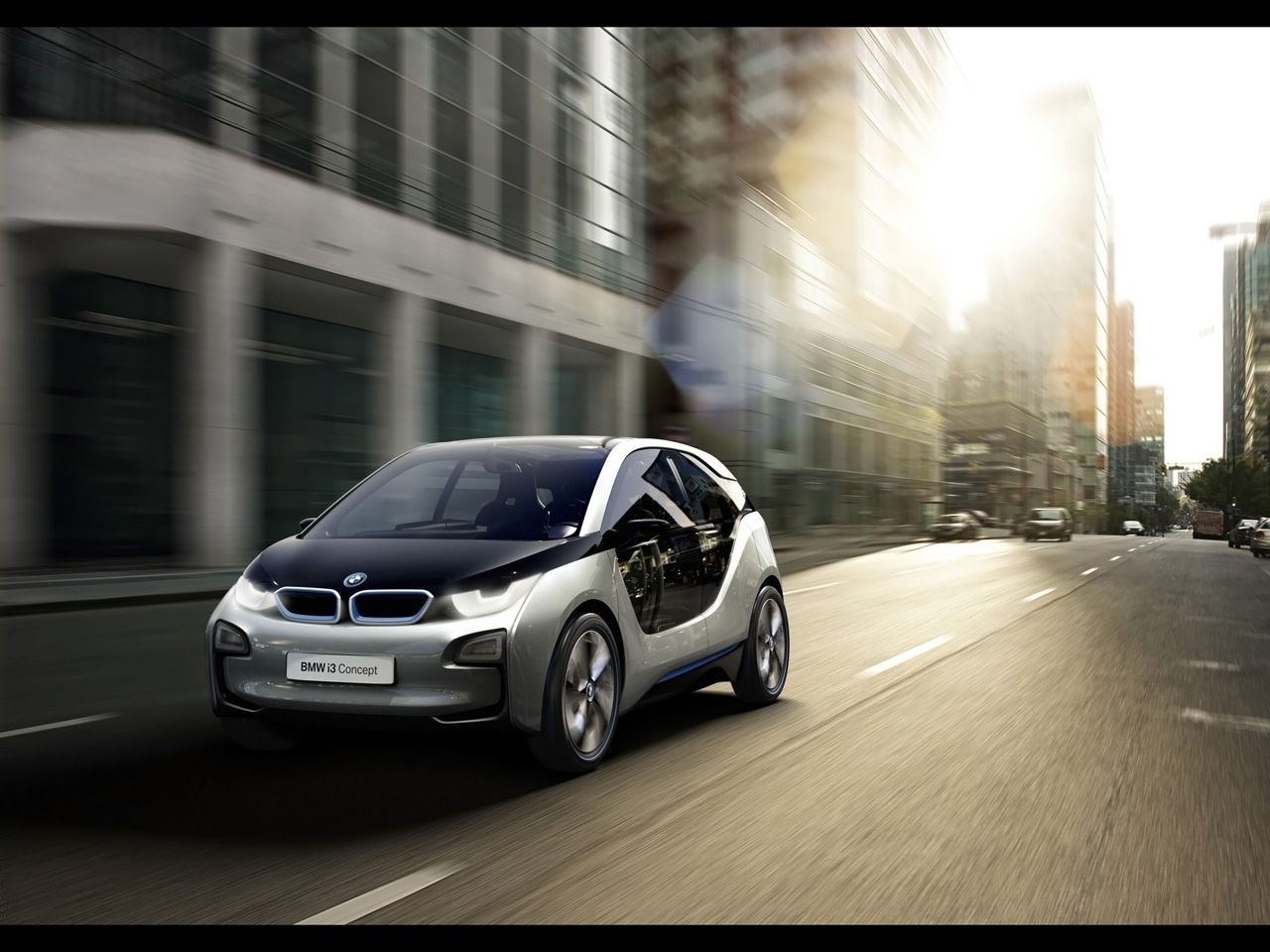
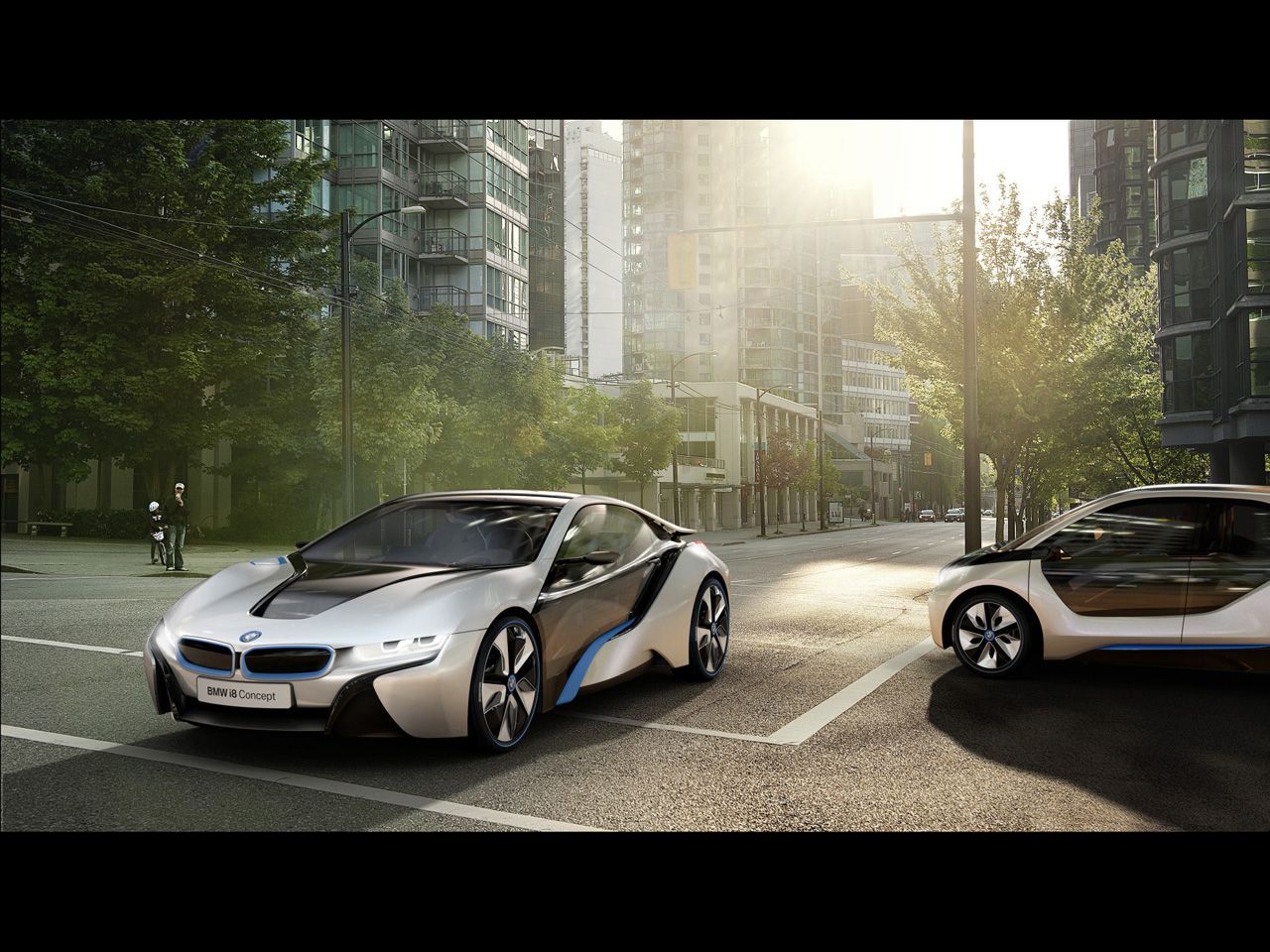
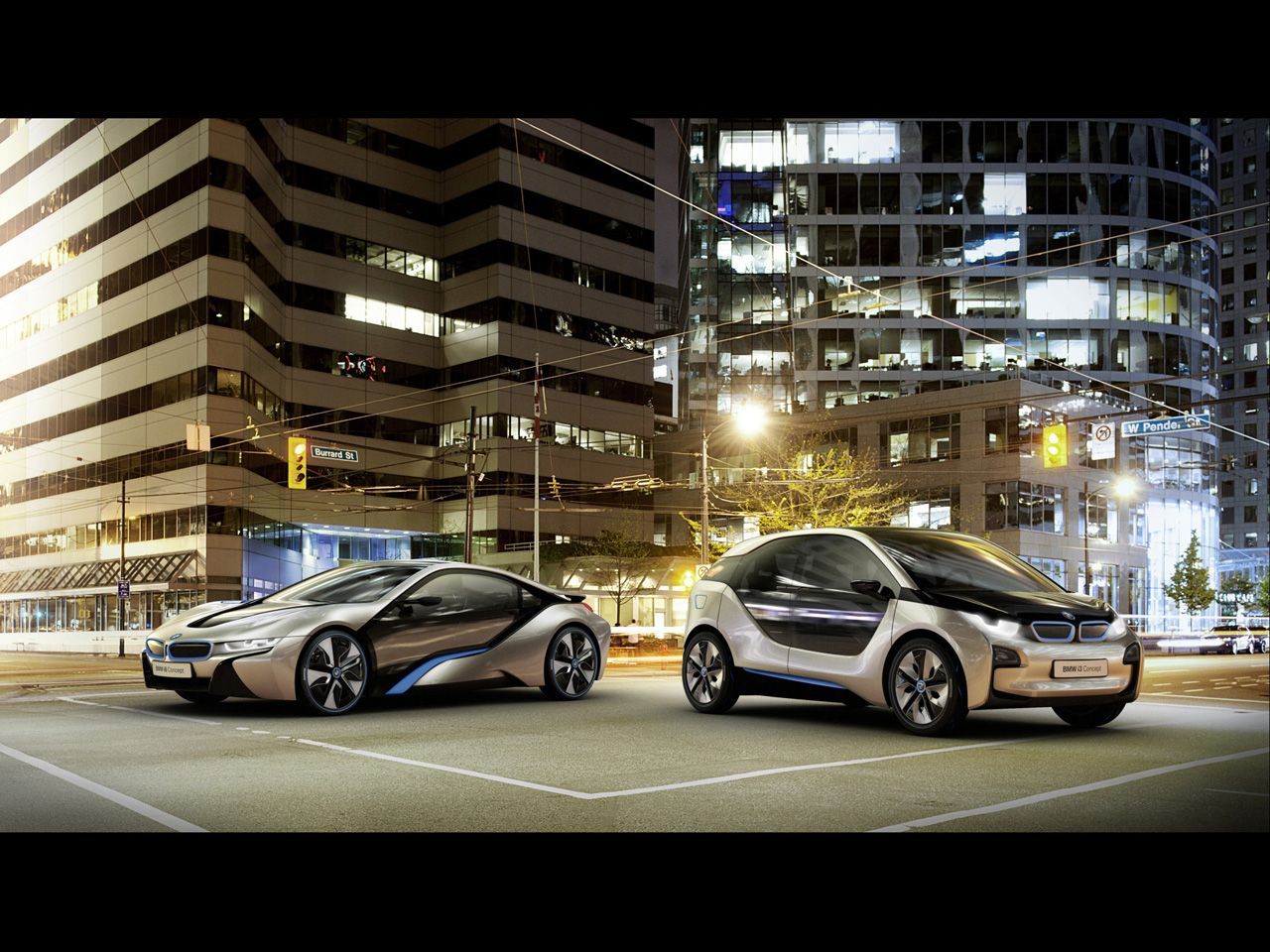
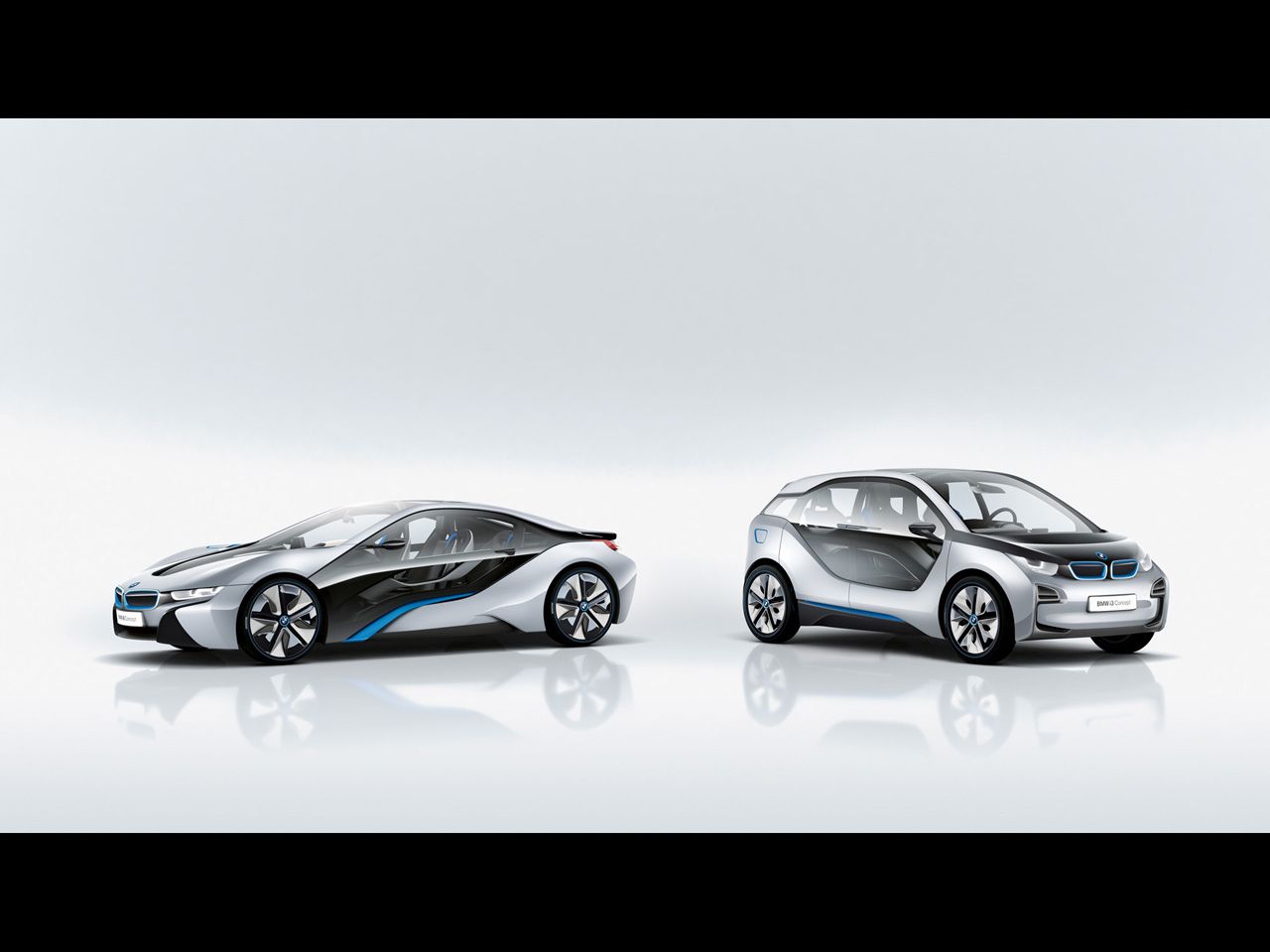
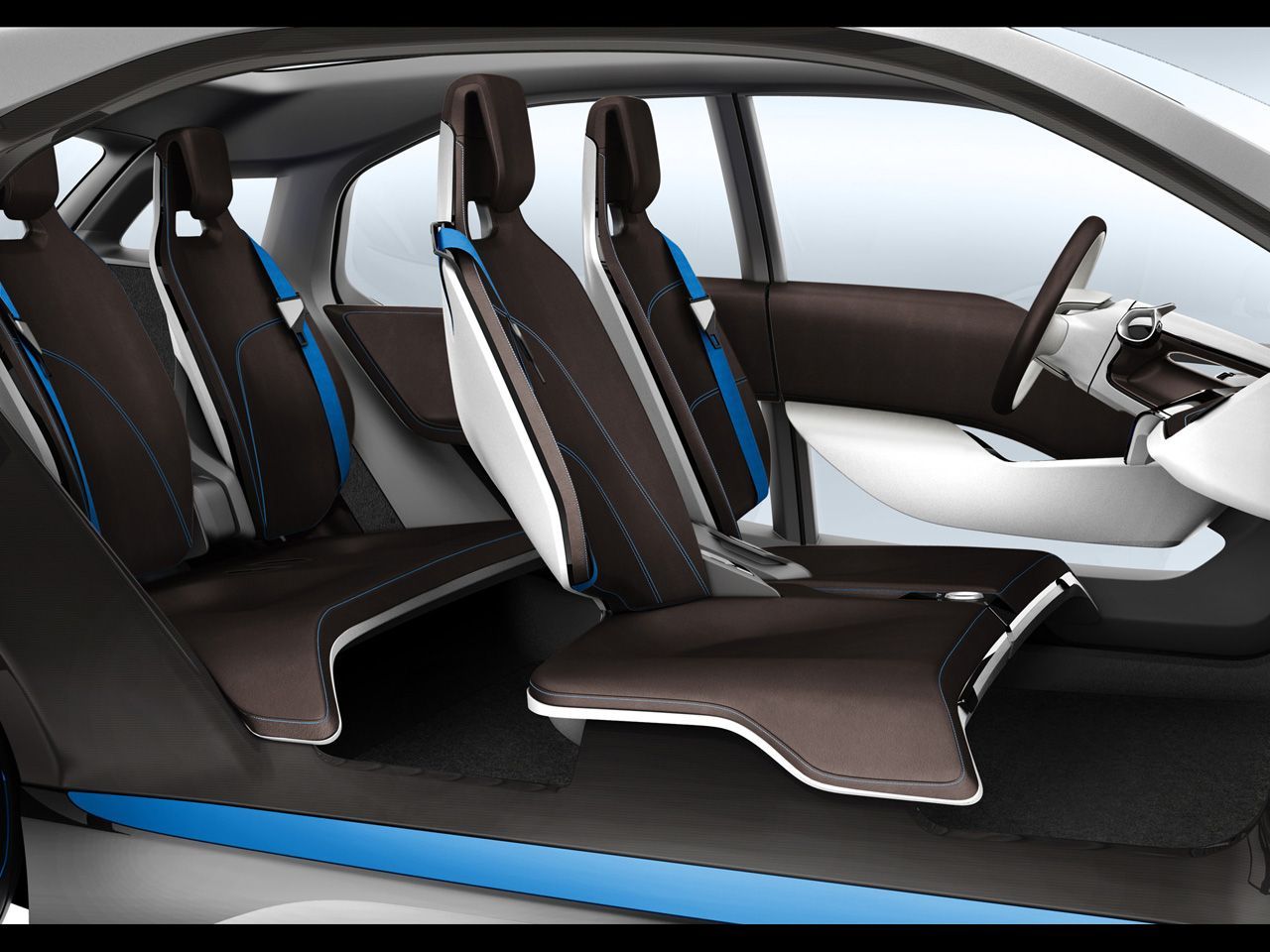
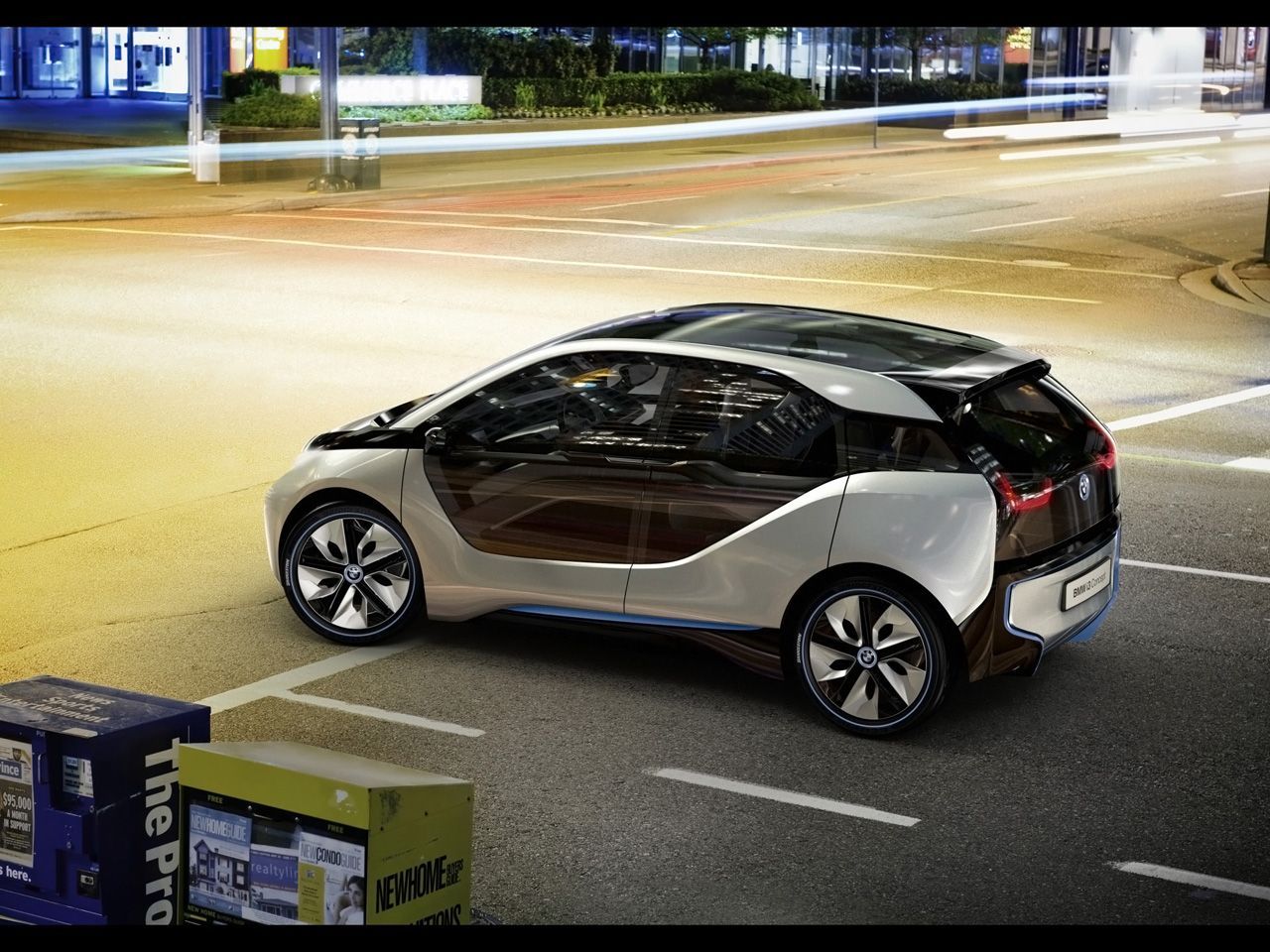
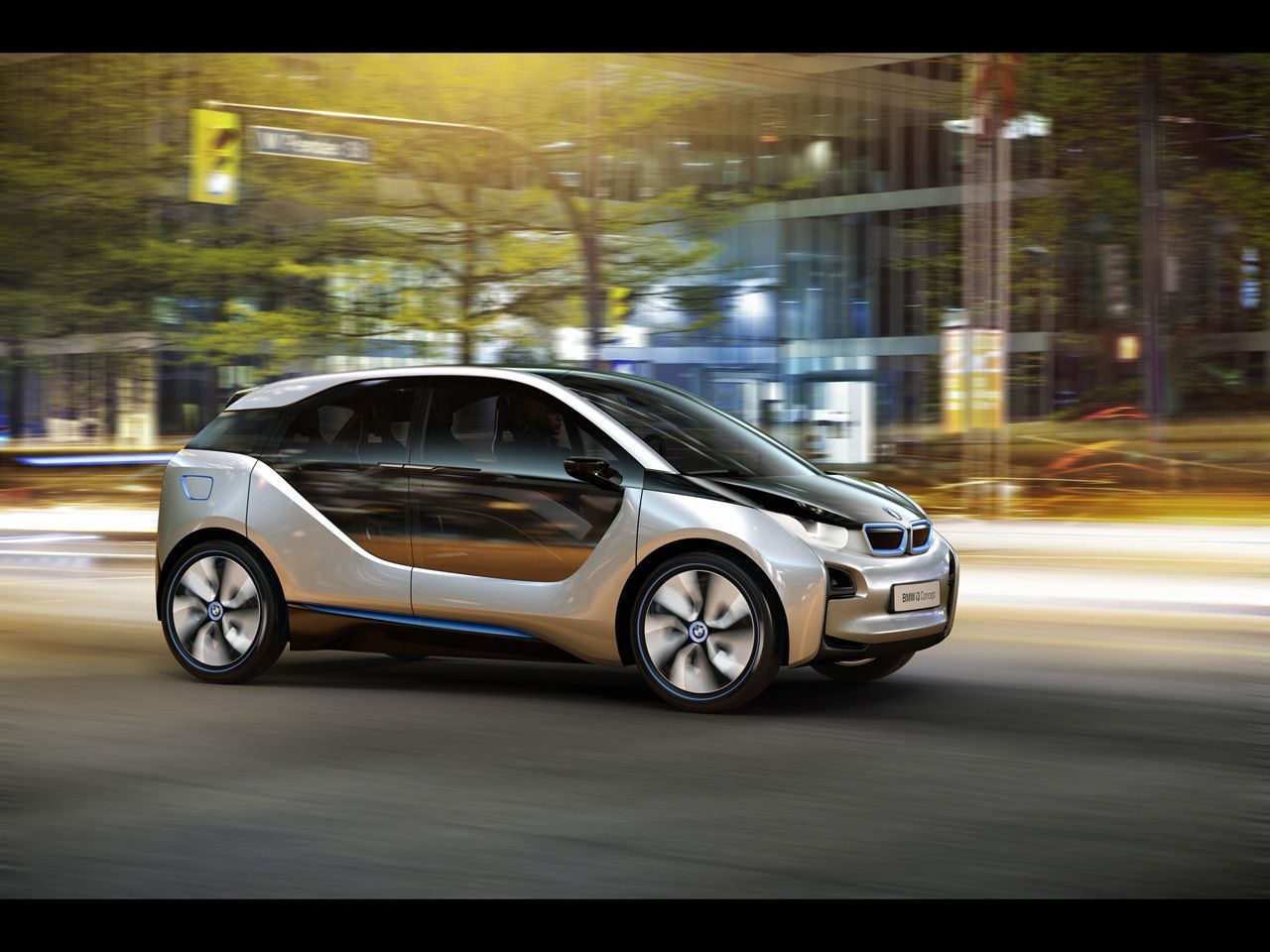
(from BMW Press Release) BMW i3 Concept – dynamic, urban, emission-free.
The BMW i3 Concept is an uncompromisingly sustainable vehicle designed for urban areas. Driven purely by electric power and purpose-built to meet the demands of sustainable and emission-free mobility, it embodies an intelligent form of urban transportation and commuting.
The BMW i3 is a well-resolved all-round concept, with every detail conceived and optimised to fulfil its eventual purpose. Its innovative LifeDrive architecture renders the BMW i3 Concept light, safe, spacious and dynamic. Innovative use of materials and intelligent lightweight design, moreover, not only enable the i3 Concept to travel long distances on a single charge and provide superb safety in the event of a collision, they also help give the car its excellent driving dynamics. The electric motor over the rear axle – which generates output of 125 kW/170 hp and impressive torque of 250 Nm (184 lb-ft) from a standstill – and a small turning circle combine to deliver pleasingly crisp driving characteristics. The BMW i3 Concept accelerates from 0 to 60 km/h (37 mph) in under four seconds and from rest to 100 km/h (62 mph) in less than eight seconds.
The so-called Life module conjures up a feeling of space inside the car more generous than even the latest conversion vehicles can offer. Select materials lend the open and airy cabin a lounge-like character. The use of renewable raw materials is another defining characteristic of the interior, offering passengers a further means of “experiencing” the sustainability of the vehicle. Parts of the instrument panel and door panelling are visibly made from natural fibres, while the naturally tanned leather of the seats creates a lounge-style ambience. With four seats, wide-opening opposing “coach” doors, a boot capacity of around 200 litres and an additional functional compartment in the front, the BMW i3 Concept is neatly equipped for the demands of everyday use.
Innovative connectivity functions create a seamless connection between the BMW i3 Concept and its customers’ lives outside the car. Remote functions accessible via a smartphone enable owners to find their vehicles, flag up nearby charging stations, allow battery charging and preconditioning at the touch of a button, and supply information on the current status of the vehicle. Meanwhile, intelligent assistance systems ease the stress on drivers in monotonous city driving situations and allow them to arrive at their destination more safely and in a more relaxed state of mind.
The LifeDrive architecture of the BMW i3 Concept.
Both the BMW i3 Concept and the BMW i8 Concept feature the LifeDrive architecture, but the geometric implementation of the concept differs in the two models, having been adapted to suit their different usages. The BMW i3 Concept features a horizontal-split variant of the LifeDrive concept. Here, the Drive module provides the solid foundations for the Life cell, which is simply mounted on top. The reason for this functional rendition of the LifeDrive architecture is the large battery. In order to ensure the greatest possible electric range, the battery in the BMW i3 Concept is correspondingly large. The most space-efficient place to store the battery cells was in the car’s underfloor section, where they occupy the whole of the module’s central section, giving the car optimum weight distribution and a low centre of gravity. The battery is penned in by aluminium profiles, which protect it from external impacts. Crash-active structures in front and behind it provide the necessary energy absorption in the event of a front- or rear-end collision. The electric drive system is, as a whole, much more compact than a comparable combustion engine, cleverly accommodating the electric motor, gear assembly and drive electronics – in space-saving fashion – within a small area over the driven rear axle. The BMW i3 Concept therefore features the optimum LifeDrive architecture configuration for a purely electric vehicle.
The integration of all the drive components within the Drive module removes the need for a centre tunnel bisecting the interior, through which power would previously have been transferred to the rear wheels. The BMW i3 Concept therefore offers significantly more interior space than other vehicles with the same wheelbase and – through solutions such as a full-width seat bench – also allows the interior to be adapted extremely effectively to the needs of urban mobility. The BMW i3 Concept offers comfortable accommodation for four passengers and, with around 200 litres of boot space, room for their luggage as well.
The chassis of the BMW i3 Concept is also ideal for city driving. Its enviably small turning circle and direct steering responses are a recipe for outstanding agility, notably at low speeds.
All-electric – the BMW i3 Concept.
The electric motor of the BMW i3 Concept is designed primarily for operation in an urban environment, developing 125 kW/170 hp, with peak torque of 250 Nm (184 lb-ft). Typically of an electric motor, maximum torque is developed from standstill, in contrast to an internal combustion engine where torque increases with engine rpm. This makes the BMW i3 Concept highly agile and provides impressive acceleration. The BMW i3 Concept accomplishes 0-60 km/h (37 mph) in under four seconds and 0-100 km/h (62 mph) in under eight seconds.
At the same time the abundant torque is delivered over a very large rpm range, resulting in very smooth power delivery. The single-speed gearbox provides optimal power transmission to the rear wheels and accelerates the BMW i3 Concept to an electronically governed 150 km/h (93 mph) without loss of power. The electric drive also allows for deceleration by means of the accelerator pedal. After the driver eases up on the accelerator, the electric motor acts as a generator, converting the kinetic energy into electricity which is then fed back into the battery. Energy recuperation generates a braking effect which makes a significant contribution to vehicle deceleration.
A coasting facility makes this unique “single-pedal control” of acceleration and braking using just the accelerator even more user-friendly. When the driver eases off the pedal, the electric motor’s zero torque control keeps the drive train disconnected as long as the pedal is in this position. The vehicle now coasts without consuming power, driven by its own kinetic energy.
Compact and powerful – the electric motor.
The electric motor of the BMW i3 Concept not only offers attractive driveability; its innovative nature is particularly evident in the favourable power-to-size ratio. As a result of continuous development and refinement, the space requirements of the electric motor used in the BMW i3 Concept have been reduced by 40 per cent compared with the motor used in the MINI E. This compact drive unit is mounted over the rear axle, together with the power electronics, transmission and differential, and does not intrude into the interior. The power needed to drive the vehicle and to operate all other vehicle functions is supplied by specially developed lithium-ion battery cells. The BMW i3 Concept’s battery system has undergone detailed optimisation which significantly reduces the extent to which external factors can influence the vehicle’s power. Furthermore, an intelligent heating/cooling system keeps the battery at its optimal operating temperature at all times, which helps to significantly boost the performance and life expectancy of the cells.
The battery can be fully recharged in six hours at a standard power socket. If a high-speed charger is used, an 80 per cent charge can be achieved in just one hour.
Range extender increases the driving range.
As the MINI E field tests showed, 90 per cent of the mobility requirements of the pilot users could be met with the range of the MINI E. However, some customers want a longer driving range, or want their vehicle to be as flexible as possible. The BMW i3 Concept therefore offers an optional range extender, the REx, which allows the driving range to be increased. REx, a small, very smooth-running and quiet petrol engine, drives a generator which maintains the battery charge level to ensure that the vehicle can continue to run on electric power.
The proportions – dynamic, compact.
The design of the BMW i3 Concept reveals the car’s qualities the first time you set eyes on it. The BMW i3 Concept represents the dynamic interpretation of an impressively practical vehicle.
Agile and compact proportions showcase the agility of the BMW i3 Concept and the dynamic prowess of its electric drive system. From the side view, the window graphics and door sills combine to create a dynamic wedge shape, giving the car the feeling of pushing forward before it even turns a wheel. From the outside, a flowing silhouette and long wheelbase hint at the extraordinarily generous levels of space on offer in the interior, while short front and rear overhangs make parking in tight spaces that much easier. Practicality gets another boost from the “coach doors”, whose opposing construction creates a fresh new way of accessing the large, open spaces of the interior.
Extensive glass surfaces and black elements like the window surrounds and door sills give the vehicle a feeling of lightness and, together with the exposed carbon structures, draw attention to its low weight. Large, narrow 19-inch wheels add further impact to the dynamic side profile.
The striking front end.
The front end of the BMW i3 Concept has a very clear and uncluttered design. The dominant element here is the strikingly moulded kidney grille, which has the hallmark BMW i blue background and – thanks to the car’s all-electric drive system – is totally blanked off. Below the kidney grille, the silver-coloured layer lends the sculptural front apron its form. Black surfaces identify the functional areas of the front end, such as the load compartment under the bonnet and the air inlets.
Clearly defined AirCurtains also lend visible expression to the honed aerodynamics of this BMW i model. The eye-catching LED headlights usher in a fresh take on BMW light design. Along with the strikingly formed kidney grille, the LED-backlit U-shaped lines form an important part of the arresting new BMW i face.
The functional rear end.
The rear end of the BMW i3 Concept represents a microcosm of the car’s impressive functionality overall. The large, retractable rear window offers optimum access to the luggage compartment, and the roof pillars stand upright to create as much space as possible in the interior. The rear window is also home to the tail lights, which are U-shaped (like the headlights) and appear to be floating in the glass. Behind it lies an extremely versatile boot area, whose capacity can be further increased by folding down the rear seats.
The wide, silver-coloured rear diffuser marks the body’s lowest edge and allows the driver to experience the car’s efficient aerodynamics. Bordered by a blue layer, the diffuser tapers heavily towards the road and appears to continue underneath the car. The form of the diffuser underlines the car’s powerful stance. A sportier version can be found on the BMW i8 Concept, forging a link between the two models.
Self-supporting and light – the interior.
The version of the LifeDrive architecture that underlies the BMW i3 Concept opens up totally new avenues in interior design. There is no centre tunnel bisecting the cabin, and the interior thus creates a very free, open and airy impression.
The passengers sit in a raised “semi-command” position which provides a good view over the hustle and bustle of city traffic and, at the same time, eases access to the seats.
The full-width seat benches in the front and rear create a new and connecting feeling of space for the passengers in the light interior. This layout also allows them to swap from one side of the car to the other and, if necessary, to all climb out of the car comfortably on the same side. This represents a major boost to comfort in tight parking spaces and when access to one side of the parked car is impeded.
A distinctive element of the light interior is the freestanding steering column. All the driving-oriented controls – such as the instrument cluster, start/stop button and gearshift lever – can be found here, rendering a centre console superfluous. Behind the steering column the extremely intricate yet extensive instrument panel spans the interior. It begins at the air vents next to the steering wheel, continues in a line around the steering column, includes the radio and climate controls, and continues on its path to the front passenger. Shortly before the front passenger door it then shears upwards, heads back towards the centre of the interior and reaches the end of its journey in the central information display (CID) monitor positioned above the control panel for the radio and climate system. Around the displays, by contrast, the instrument panel generates an almost calligraphic surface design in which one large, wide surface sweeps prominently into a narrower and more delicate counterpart, before culminating in another wide section. The CID and control unit therefore present an attractive contrast to the clear, precise borders of the instrument panel.
The area around the instrument panel, the doors and the floor area of the BMW i3 Concept also features contrasting materials. The natural origins of the high-strength dark anthracite material made from compressed and coated plant fibres are clearly evident and showcase the light, high-quality and beautifully crafted elements of the interior to optimum effect.
Interface design.
Connectivity – the linking up of the driver and passengers with the outside world and information superhighway – plays an important role in the BMW i3 Concept. Three large displays act as interfaces between the vehicle and the outside world. The 6.5-inch (16.5 cm) instrument cluster, meanwhile, emerges out of the steering column directly in front of the driver. Its freestanding design generates a very free and open feel around and above the driver’s head. Meanwhile, the central 8.8-inch (22.4 cm) information display (CID) curves out of the black technical layer of the instrument panel’s upper section towards the passengers. It blends seamlessly into the black surrounds, creating a very high-quality, continuous black surface which makes the display appear even larger. Below, the likewise unbroken black audio/climate control panel shares the form of the CID. Like the CID, the homogeneous touch-control surface curves towards the passengers and uses another screen to show additional information relating to the content on the central information display.
On another level, the highly technical-looking display graphics of the instrument cluster and CID lend visual form to the BMW i3 Concept’s electric drive philosophy. All the information is displayed in the high quality and visually appealing fashion you would expect from BMW. Although the relationship of the i3 Concept to the parent brand is clearly evident again here, a very distinctive graphics profile has been created for BMW i with the emphasis on an individual and minimalist approach.
